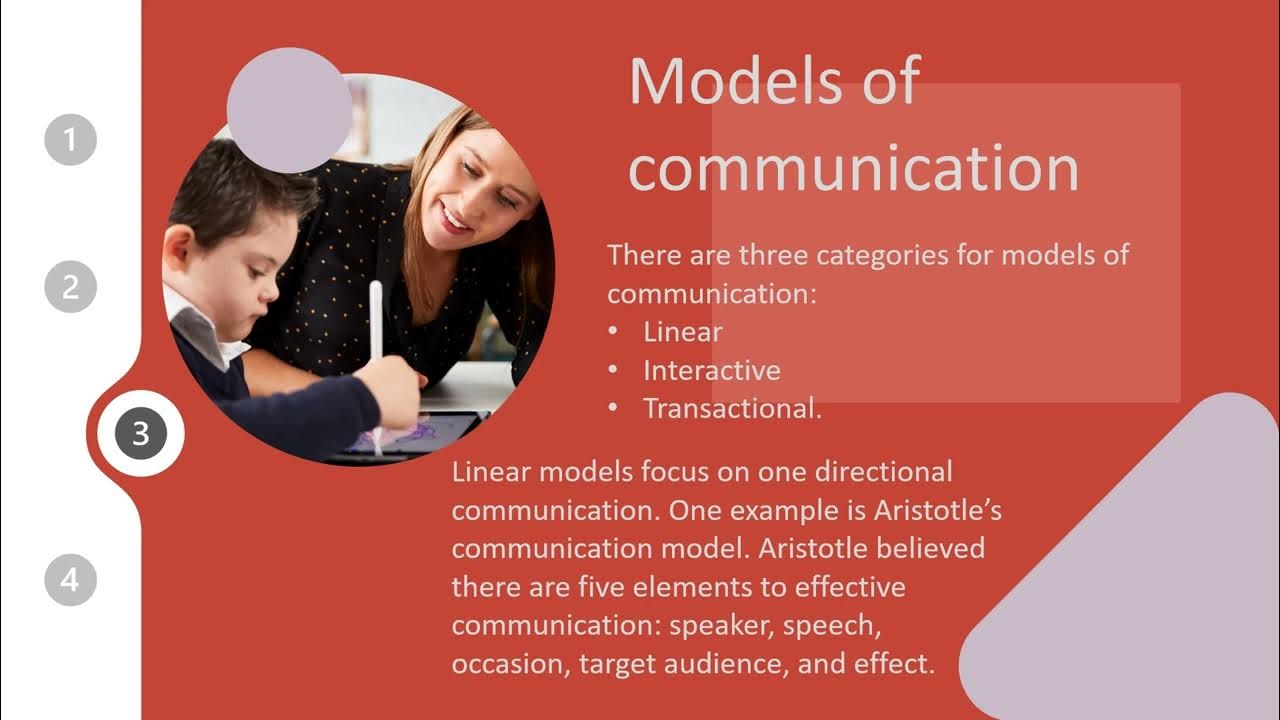Special Recipes of Communication (Schramm's Model of Communication)
Summary
TLDRThis video introduces the Wilbur Schramm model of communication, highlighting the significance of feedback and the 'field of experience' in effective communication. Schramm's model emphasizes that both sender and receiver take turns as encoder and decoder, making feedback essential to the communication process. The field of experience refers to the shared context between communicators, necessary for accurate message interpretation. The video also touches on the circular nature of communication, as refined by Osgood and Schramm, demonstrating how communication is interactive and continuous.
Takeaways
- 📡 Shannon Weaver’s model of communication laid the foundation of communication models, introducing the concept of noise.
- 🔄 Wilbur Schramm’s 1954 model emphasized the interactive nature of communication where both sender and receiver act as encoder and decoder.
- 📤 Feedback plays a crucial role in communication, enabling the sender and receiver to take turns in the communication process.
- 🌍 Schramm introduced the concept of 'field of experience,' highlighting the sociological context shared by both sender and receiver.
- 🧠 Effective communication requires a common 'field of experience' or shared understanding between the people involved.
- 💬 Miscommunication can occur when the sender’s meaning differs from how the receiver decodes the message, as shown in the example of interpreting 'I love you.'
- ⚙️ Osgood collaborated with Schramm to further develop the model, emphasizing a circular or interactive communication process.
- 🔄 The updated model, known as the Osgood-Schramm circular model, focuses on the continual exchange of roles between sender and receiver.
- 🧭 The field of experience still plays a significant role in the circular model, impacting how people interpret messages.
- 🎥 The video encourages viewers to like and subscribe for more communication insights.
Q & A
Who introduced the concept of feedback in communication models?
-Wilbur Schramm introduced the concept of feedback in communication models.
What is the significance of feedback in Schramm's model?
-Feedback in Schramm's model signifies the interactive nature of communication where both the sender and receiver take turns playing the roles of encoder and decoder.
What does the term 'field of experience' refer to in the context of Schramm's communication model?
-The 'field of experience' refers to the sociological aspect of communication, which includes the context or everything surrounding the message that both the sender and receiver share.
How does the field of experience impact the encoding and decoding of messages?
-The field of experience impacts encoding and decoding by ensuring a commonality in meaning between the sender and receiver, which is necessary for a signal or understanding to occur.
What is an example given in the script to illustrate the importance of shared field of experience?
-The example given is when a person encodes the message 'I love you' intending it as a friend, but the receiver decodes it romantically, thinking the sender wants to be their boyfriend or girlfriend.
What is the circular model of communication?
-The circular model of communication, also known as the Osgood and Schramm model, emphasizes the circular or interactive nature of communication where individuals alternate between being encoders and decoders.
Who contributed to the development of the circular model of communication?
-The circular model of communication was developed by Charles Osgood in collaboration with Wilbur Schramm.
How does the circular model differ from earlier models of communication?
-The circular model differs from earlier models by illustrating the continuous cycle of communication where every individual serves as an interpreter, maintaining the concept of the field of experience.
What is the role of the field of experience in the circular model?
-In the circular model, the field of experience is emphasized as every person in the communication experience serves as an interpreter, contributing to the continuous cycle of encoding and decoding.
What does the term 'encoder' mean in Schramm's communication model?
-In Schramm's communication model, an 'encoder' is the person who translates a message into a transmittable form, preparing it for communication.
What does the term 'decoder' mean in Schramm's communication model?
-In Schramm's communication model, a 'decoder' is the person who interprets the received message, translating it from its transmittable form back into a meaningful message.
Outlines

This section is available to paid users only. Please upgrade to access this part.
Upgrade NowMindmap

This section is available to paid users only. Please upgrade to access this part.
Upgrade NowKeywords

This section is available to paid users only. Please upgrade to access this part.
Upgrade NowHighlights

This section is available to paid users only. Please upgrade to access this part.
Upgrade NowTranscripts

This section is available to paid users only. Please upgrade to access this part.
Upgrade Now5.0 / 5 (0 votes)





